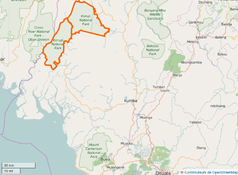Korup National Park
| Korup National Park | ||
|---|---|---|
| Location Korup National Park in western Cameroon | ||
|
|
||
| Location: | Sud-Ouest , Cameroon | |
| Next city: | Mouth emba | |
| Surface: | 1250 km² | |
| Founding: | 1984 | |
The Korup National Park is a national park in Cameroon .
geography
The national park is located in southwest Cameroon on the border with Nigeria . It also borders the Nigerian Cross River National Park . It is 1250 km² and consists mostly of tropical lowland rainforest .
history
The park was founded in 1984 and inaugurated by Prince Charles in 1990. Contrary to the original plans, six villages within the park boundaries were not relocated. The smugglers' routes to Nigeria run through the park. Poaching is such a big problem that the WWF stopped its work in the park in 2004. In the park there are several clean camps and easy-to-walk trails, the most beautiful one leads to a group of rocks from which you have a wonderful view over the rainforest.
flora
620 species of trees and shrubs were counted in Korup National Park, among other things as part of a project by the Smithsonian Institute. The forest density is extremely high, with 7500 trees per hectare. There are also almost 500 types of herbs and lianas. The trees can reach a height of up to 50 meters. One of the most interesting belongs to the legume family and is called Microberlinia in Latin and is also a tourist destination thanks to its huge buttress roots.
The trees include cola ( e.g. Cola nitida ), ebony plants ( e.g. Diospyros pseudomespilus ) and legumes ( e.g. Eurypetalum unijugum ).
In 1987 the American National Cancer Institute discovered an interesting new plant in Korup National Park. A liana , the species Ancistrocladus korupensis , contains the active ingredient michellamine B , which is supposed to inhibit the HI virus . The monomeric building blocks of naturally occurring naphthylisoquinoline alkaloid dimers of michellamine B lead to high anti- HIV-1 and -HIV-2 activity.
fauna
25% of all African primate species occur in the Korup National Park . Among other things, you can find chimpanzees and the very rare drills and Preuss colobus monkeys here , as well as forest elephants , ducks and pangolins .
Around 690 species of birds live here, including the crowned eagle . Among other things , he hunts monkeys , but the park's duikers are also frequently captured by him.
- Others
There are also occurrences of Papilio antimachus in the area, one of the largest butterflies in Africa.
Conflicts of Interest
In the immediately adjacent areas south of Korup National Park, a New York company is planning to convert 70,000 hectares of forest into palm oil plantations . Researchers criticize that this could disrupt wildlife trails into the national park. Local residents and non-profit organizations are resisting these plans. In 2012, two Cameroonian courts declared the project illegal.
Web links
- UNESCO World Heritage List : Parc national de Korup
Individual evidence
- ^ Stri: Smithsonian Tropical Research Institute-Korup Plot Information. (No longer available online.) In: ctfs.si.edu. Archived from the original on December 30, 2016 ; accessed on December 30, 2016 . Info: The archive link was inserted automatically and has not yet been checked. Please check the original and archive link according to the instructions and then remove this notice.
- ^ Stri: Smithsonian Tropical Research Institute-Korup Species Abundance. (No longer available online.) In: ctfs.si.edu. Archived from the original on December 30, 2016 ; accessed on December 30, 2016 . Info: The archive link was inserted automatically and has not yet been checked. Please check the original and archive link according to the instructions and then remove this notice.
- ↑ http://de.mongabay.com/rainforests/10anti_HIV.html
- ↑ DNB 966062906/34
- ↑ Gimenez Dixon, M. 1996. Papilio antimachus. In: IUCN 2009. IUCN Red List of Threatened Species. Version 2009.1.
- ↑ http://green.blogs.nytimes.com/2012/09/05/report-assails-palm-oil-project-in-cameroon/
- ↑ http://wwf.panda.org/who_we_are/wwf_offices/cameroon/?206114/Cameroon-biodiversity-hotspot-in-grave-danger-as-palm-oil-conglomerate-quits-sustainability-group
- ↑ https://www.regenwald.org/aktion/727/kamerun-palmoelprojekt-bedroht-menschen-und-regenwald


